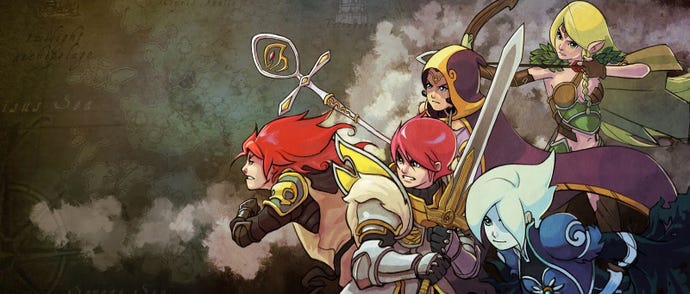Clash! The Story Behind an All-Time Classic
Eurogamer's Rich Stanton examines how Capybara made Clash of Heroes, the game that changed the studio forever.
This article first appeared on USgamer, a partner publication of VG247. Some content, such as this article, has been migrated to VG247 for posterity after USgamer's closure - but it has not been edited or further vetted by the VG247 team.
Next to my desk I keep an old pocket watch. It's not there for any practical reason; I sometimes wind it up, but more often I turn the cool oblong over in my hands, following the engraving on the case and marvelling at the inner workings. It keeps time perfectly, if required. But I keep it because it feels like treasure.
That sensation, a well-made thing that acquires an aura of magic, is something every developer would love to capture -- yet how few do. Toronto's Capybara Games is one of the exceptions, having recently brought a little wonder back into adventure games with Sworcery (co-developed with Superbrothers), an offbeat follow-up to the studio's breakthrough titles Critter Crunch and Clash of Heroes. Capy is currently working on Super Time Force, which is Contra on (good) drugs, the awesome-looking Below (a timed exclusive for Xbox One), and another unannounced title. Its growth and projects are a shining example to other indie developers but getting here wasn't easy -- and it involves a little grey DS cartridge that I consider a true treasure: Might & Magic: Clash of Heroes.
Capybara was founded in 2003, but the team was working in its spare time until, in Autumn 2005, there was finally office space -- and a whole bunch of licenses. "At the time I'd say 90 per cent of what we did was work for hire," says Nathan Vella, Capybara's co-founder and president. "Pre-smartphone cellphone games, so old crappy devices where games can only be 256kb, you couldn't press two buttons at once, things like that. We were making games for things like Cars, Pirates of the Caribbean, Happy Feet, Scarface, ESPN. It was pretty harsh. Quality was not necessarily a focus for these games whereas for us that was all that mattered. We wanted to make rad s**t."

As 2006 rolled around, in a corner of the studio was Capybara's remaining 10 per cent; Top of the Food Chain and then later Rising Tide. These games would eventually morph into Critter Crunch and Might & Magic: Clash of Heroes, but the prototypes were being worked on during a third and then a fourth year of gruelling mobile development. "The way I remember that time personally," says Kris Piotrowski, Capybara's co-founder and creative director, "is that we were feeling exhaustion. It was the moment we were either going to turn the bus or other dramatic things would happen.
"We were making two to four mobile work-for-hire projects every six to seven months, so really churning it out. And yet with all of those games we were desperately trying to maintain quality because that was always so important for us as a studio. Basically we were putting ourselves through the wringer and not seeing any progress, an endless work cycle that didn't lead to anything but the next contract for a Hollywood blockbuster. The whole studio was becoming tired of what we were doing and how we were working."
One possible way out was an original title called Rising Tide. "At the time I thought I was a genius or something," laughs Piotrowksi, "it was a puzzle RPG that combined a Zelda-like overworld but every time you touched the monsters it would launch into this puzzle system." Rising Tide would draw on Capybara's experience in making mobile games, and aim for high end platforms that supported Brew.
"But this predates the iPhone and App Store era by quite a bit," says Piotrowski. "And it was very difficult at that time to create and publish original games in that market. We took Rising Tide 90 per cent of the way there. The entire adventure was playable, we were at a point of just polishing this thing. Then we suddenly realised that nobody wanted to publish it because of how the mobile market was set up at the time, and self-publishing at the time just wasn't available to us. So we made a decision, as a studio, that we'd do whatever it took to get out of mobile."
Capybara had a new determination after seeing other indies breaking out with creative titles, including Toronto-based developers like Mare Sheppard (N, N+) and Jonathan Mak (Everyday Shooter). "What we did was decide to try and get Rising Tide off the ground and use what we had which was our 'puzzle expertise' to try and get onto the DS," says Piotrowski.
"The DS at that point was picking up a lot of steam," says Nathan Vella. "It had a s**t-ton of great games, and for us it also made a lot of sense -- we could apply a lot of our small-screen learnings and try to take some positives out of the time we spent doing cellphone stuff. We put together this whole document outlining a lot about this DS title, but we didn't have a name for it. Then Kris came up with something..."
"Little Big Battle," laughs Piotrowski. The timing couldn't have been crueller. "So we went to GDC [2007] and in my hand there's a beautiful glossy pitch with amazing pixel part and it's this original game called Little Big Battle. I got the name from that Dustin Hoffmann movie Little Big Man. I thought it was the best name ever. Little Big Battle, right? It has such a nice flow to it. We had this great logo, all this nice art, and it also illustrated this was a puzzle game where you used characters. So we were sitting in the Sony talk, feeling great and then 'Announcing our huge new thing, LITTLEBIGPLANET!' What?!?"

"We were so stoked to go to GDC and meet publishers," laughs Vella, "We knew we needed one. Then Media Molecule announces LittleBigPlanet. And so we show up just after that with a game called Little Big Battle like a bunch of fuckin' chumps!"
Despite this hiccup, several publishers liked the look of Little Big Battle. "Ubisoft was pretty interested," says Piotrowski, "and asked us what we thought about having the opportunity to make the game, but rebranding it from our characters and our world to their Might & Magic universe. At the time we just wanted to make something that wasn't a mobile game. The idea of a DS game was so appealing -- and important -- to us at that time. So we looked at that and went 'You know what? Screw it. Let's do this and get a game out there that's in a box and in a different category.' And then Little Big Battle became Clash."
"That was the give-and-take," says Vella. "We loved the game idea and they loved the idea of it together with the brand. At the time we spent a couple days talking among ourselves about well OK what would the story be? 'Ah, we'll deal with that later!' [laughs] We'd done nothing but cellphone games at that point, so the fact it had that brand was the toll we paid to get it made, and I would pay that again and again. We ended up because of it working with some amazing creative people from Ubisoft Paris that were like the Might & Magic managers, and they had a mega bible that was utter insanity -- this thing's like the Silmarillion."
"Actually I really enjoyed reading that stuff," laughs Piotrowski, "because I grew up reading monster manuals and Games Workshop so it was like a whole bunch of homework." The most remarkable thing about Clash is that it gave Might & Magic, surely the stodgiest of all fantasy brands, a fresh makeover. "I agree it's kind of the most generic of the fantasy brands in that it mashes together as many different aspects of the genre as it can," says Piotrowski. "It's casting a giant wide net, both aesthetically and narratively -- you know, like this isn't 'fantasy' it's 'FANTASY!' The interesting thing in that light is that Ubi did allow us to do whatever we wanted."
And Capybara did. The studio's creativity was no longer bound in the confines of prehistoric cellphones and, alongside the gorgeously fat and colourful Critter Crunch, the magnificent spritework at the heart of Clash showed a huge talent had been slumbering. These are sprites to fire the imagination: the burning eyes of a bear tensed to strike, the clenched and hidden fist of a mage, the chains bursting free from a ghost at it heads straight for you.
"There's something really special about small-screen, low-detail pixels," says Vella, "because you spend a lot of your time with the game in your imagination rather than this one-to-one where what you see is what your brain pictures. I think that really worked in our favour our lot. And it fits with Nintendo, right? The DS was very much in my opinion about not cutesy but happy visuals, brighter colours and smiling characters. That was something we did on purpose. Even the Castlevania games on DS, they're not gothic, they have a kind of charm like a Nintendo aura. And that worked for Clash too, I really love the art in that game. I think it was really a chance for us to flex that muscle and because of that game directly or indirectly we want to keep flexing it. Sworcery was Superbrothers doing all the artwork so until we started Super Time Force we hadn't done a pixel game since Clash and were very aware of that."
"A lot of stuff happened between the development and release of that game I'm not super-stoked about," says Vella, "but one of the most strange and best things about it was that Ubisoft just let us make the game. I think once we showed them that we knew best for the game, they were very hands-off in ways that I didn't expect. That kind of stuff is quite small compared to how we've seen it go elsewhere with other big publishers, the Hand of God reaching into the studio and typing for you. It's pretty insane how in control of that project we were from a creative standpoint."
"It took us a while to become the Capy we are now where we're working on three original games that are our own."
Kris Piotrowski



Not that everything went to plan: the development included one huge reversal. "It was originally real-time," says Vella. "We worked on it for so long, totally didn't like anything about it, didn't like the engine, didn't like the workflow, and we were 'umm, Ubisoft? We're going to start from scratch again if that's OK?' We half-expected them to cancel it but they didn't!"
"We started with Rising Tide," says Piotrowski, "which was real-time, so when we kicked off we just continued with what we had. And there was a moment just over the halfway mark of the project that we tried the turn-based version. We were trying to find the best sort of balance between the strategy and the puzzle, and with the real-time version it felt a little bit more of a combination between action and puzzle with some very light strategy to it. We weren't happy with that feel and were kind of wrestling with it, but then the moment we switched it over to turn-based it slowed it down and allowed us to think of other ideas that simply weren't visible when the game was so much faster paced."
Soon after this switch, Piotrowski realised for the first time that Capybara might have created something special. "I was testing it so I'd go home and just play the game. There was one night where I was suddenly playing for seven hours on a build that just had the quick battle system. I was kind of 'Holy s**t, I just got hooked on our game.' And it was definitely after the turn-based decision. From that call we were able to refine ideas like linking and fusing and the combo system, how you'd return moves to yourself."
"When we slowed it down we were able to put more things directly into the player's move set. Then all of these things started to work together: when you reinforce, how you get rid of things, how to get moves back -- even the idea of moves wasn't in the real-time version, and that's such a core part of why the final game feels like it does."
Clash was originally slated for release in Summer 2009, but as it increased in size that was pushed back -- plus, there was another problem. Ubisoft (and every other third-party publisher) was terrified of a new arrival to the DS scene: the R4 cart, a foolproof flashcard for pirating games.
"We were getting close to finishing at the time the DS piracy terror was in full swing and we ended up spending tons of time putting in copyright protection stuff that did absolutely nothing," says Vella. "I think the piracy fears were part of a lot of third parties dialling back their DS spend." By the time Clash of Heroes released, in December 2009, the chances of a third-party hit -- never mind a fantasy-themed puzzle game -- were slim.
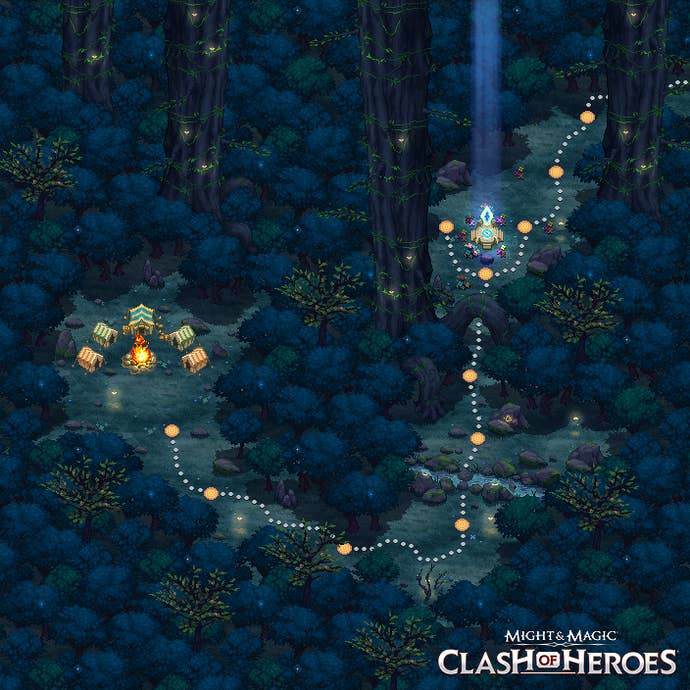
"Ubisoft was never going to push it, because no matter what happened it was never meant to be a big title," says Vella. "Ubisoft's DS process wasn't really to have big titles; they had lots of titles, and at that point in the DS lifecycle everyone was popping off. But then Clash was and is their best-reviewed DS game of all time, and I think in Metacritic it's still in the top 25 of like 4000 games. That's not a game that it seems to me you just throw out, but it did get thrown out there. We were out two days before Zelda. If you're ever going to die on DS, that's how to do it."
"To be honest by that time with third-party games on the DS," says Piotrowski, "it wasn't a good place to be. We're making a game that we're incredibly invested in and have been making for a long time -- but it does make sense that that is only a tiny corner of Ubisoft. That's just the way things work. We made Clash primarily so we could make a game that for the first time showcased the studio outside of the mobile environment, and introduce us to -- to real gamers, basically. To someone who enjoys playing things rather than wasting some time on the bus. So for us the critical response was mission accomplished. That was our best-case scenario. We never thought it would be a giant hit. But we were also really pleasantly surprised by how well it was received by players and critics, and I think that did us a lot of good down the line. It didn't make anyone buckets of money but it really helped put us on the map."
I didn't play Clash of Heroes at the time, despite the avalanche of amazing reviews and awards. My first experience was on PC, where it absolutely blew me away, and after a few hours I'd ordered the DS cart. Part of it was the pixels, but mostly it was the fit; what kind of game Clash is and how it works across that hardware's screens. A little fetishistic, perhaps, but these things matter -- that DS card has an aura that others don't. That tiny grey cart feels like a treasure.
How Capybara turned itself from a work-for-hire developer into one of the indie scene's leading lights isn't just about Clash of Heroes, and sadly there's no room for an equally detailed look at Critter Crunch. But one aspect of the latter does deserve mention, because it surely contributed more than anything to the quality of Clash.
In early 2008, just after Clash had moved into full production, Capybara made their first splash when Critter Crunch won both the IGF mobile grand prize and audio prize. "Then right at that moment when Critter Crunch won the IGF there was a brand new ray of excitement that arrived at the studio," says Piotrowski. "We saw a way to kind of jump out of this burning car and into something else. And we took it. I think it was good. I personally wish we'd done it earlier, but because of the nature of the studio, the size it was, it was very hard to change direction on a dime. It took us a while to become the Capy we are now where we're working on three original games that are our own games, and when they come out they'll be helping the studio."
"We were out two days before Zelda. If you're ever going to die on DS, that's how to do it."
Nathan Vella
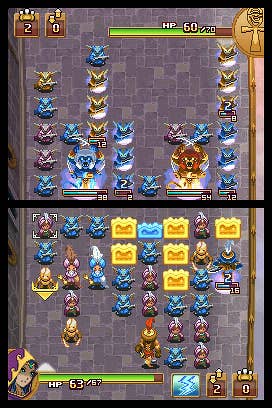
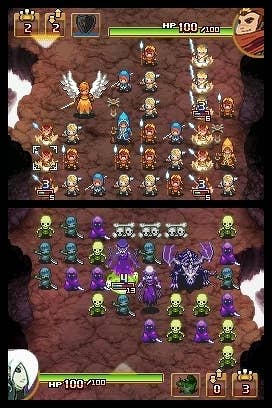

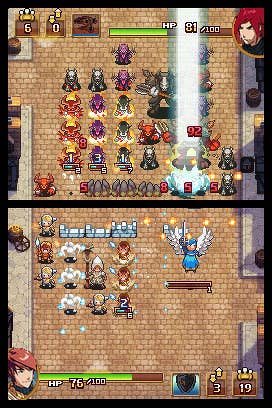
"It took us ten years to get there, in fact!" Piotrowski laughs. "But Clash and Critter Crunch were the first steps in that direction, and they came out of what I'd call the dark days. That's how it felt! For me and for, I think, a lot of us here. Rising Tide and Critter Crunch were the two things happening in the corner of the studio that were keeping us basically sane. The little flame in the corner keeping us warm while we worked on all this other depressing stuff."
These days Capybara threads such an unusual route through experience and mechanics that Clash of Heroes leaves me with one question: will we ever see such a straightforward game from the studio again? Because for all they may be indie darlings, Capybara do old-school brilliantly.
"We're really interested in continuing to make gamey games like Super Time Force, mechanics-driven stuff, a straight line from player to game and that's what it is," says Vella. "At the same time we're really interested in the Below type stuff, where there's no text in the game, no tutorials, it's about you being this tiny character in a randomly generated world and the art and the music, and that experience of exploring and surviving and discovering. I think it's rad."
"And I think that's.... this might sound a bit cocky but I don't care, that's one of the things I'm most proud of at this studio, one of these things we do that there aren't a lot of other people out there doing. We can be running a team doing a really interesting mechanics-driven game, and also be doing an experimental kind of game - and it doesn't seem weird or strange we're making those two things."
The fact that Clash of Heroes didn't change the world hardly matters: it changed Capybara.
"We're now at a point where we're very comfortable with what we want to do," ends Vella. "And what we want to do is have our cake and eat it."
